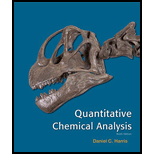
a)
Interpretation:
The usage of split, splitless or on-column inject in gas chromatography has to be given.
Concept Introduction:
Split injection:
Split injection is necessary for solutions in very dilute form. Split injection is most suitable for analyte with high concentration. They offer poor quantitative analysis and compounds with less volatile nature could be lost during injection. Split injection could handle samples that are dirty (if adsorbent packing is summed to injection liner). The decomposition of unstable compounds takes place during high temperature injection.
Splitless injection:
Splitless injection is necessary for solutions in very dilute form. Splitless injection is most suitable for analyte with high concentration. They offer poor quantitative analysis and compounds with less volatile nature could be lost during injection. Splitless injection is better than split injection for compounds that have moderate thermal stability because the injection temperature would be lower. Since the sample is injected slowly, solvent trapping and temperature programming is required.
On-Column injection:
On-column injection is the best method for quantitative analysis for compounds that are thermally sensitive. It is low resolution technique and doesn’t support for columns with diameters less than 0.2 mm. On-column injection can be used to handle solutions that dilute and concentration in solution both in large and small volumes.
To give the use of split, splitless or on-column inject in gas chromatography
b)
Interpretation:
The process of solvent trapping and cold trapping in splitless injection has to be explained.
Concept Introduction:
Splitless injection:
Splitless injection is necessary for solutions in very dilute form. Splitless injection is most suitable for analyte with high concentration. They offer poor quantitative analysis and compounds with less volatile nature could be lost during injection. Splitless injection is better than split injection for compounds that have moderate thermal stability because the injection temperature would be lower. Since the sample is injected slowly, solvent trapping and temperature programming is required.
To explain the process of solvent trapping and cold trapping in splitless injection
Want to see the full answer?
Check out a sample textbook solution
Chapter 24 Solutions
Quantitative Chemical Analysis
 ChemistryChemistryISBN:9781305957404Author:Steven S. Zumdahl, Susan A. Zumdahl, Donald J. DeCostePublisher:Cengage Learning
ChemistryChemistryISBN:9781305957404Author:Steven S. Zumdahl, Susan A. Zumdahl, Donald J. DeCostePublisher:Cengage Learning ChemistryChemistryISBN:9781259911156Author:Raymond Chang Dr., Jason Overby ProfessorPublisher:McGraw-Hill Education
ChemistryChemistryISBN:9781259911156Author:Raymond Chang Dr., Jason Overby ProfessorPublisher:McGraw-Hill Education Principles of Instrumental AnalysisChemistryISBN:9781305577213Author:Douglas A. Skoog, F. James Holler, Stanley R. CrouchPublisher:Cengage Learning
Principles of Instrumental AnalysisChemistryISBN:9781305577213Author:Douglas A. Skoog, F. James Holler, Stanley R. CrouchPublisher:Cengage Learning Organic ChemistryChemistryISBN:9780078021558Author:Janice Gorzynski Smith Dr.Publisher:McGraw-Hill Education
Organic ChemistryChemistryISBN:9780078021558Author:Janice Gorzynski Smith Dr.Publisher:McGraw-Hill Education Chemistry: Principles and ReactionsChemistryISBN:9781305079373Author:William L. Masterton, Cecile N. HurleyPublisher:Cengage Learning
Chemistry: Principles and ReactionsChemistryISBN:9781305079373Author:William L. Masterton, Cecile N. HurleyPublisher:Cengage Learning Elementary Principles of Chemical Processes, Bind...ChemistryISBN:9781118431221Author:Richard M. Felder, Ronald W. Rousseau, Lisa G. BullardPublisher:WILEY
Elementary Principles of Chemical Processes, Bind...ChemistryISBN:9781118431221Author:Richard M. Felder, Ronald W. Rousseau, Lisa G. BullardPublisher:WILEY





